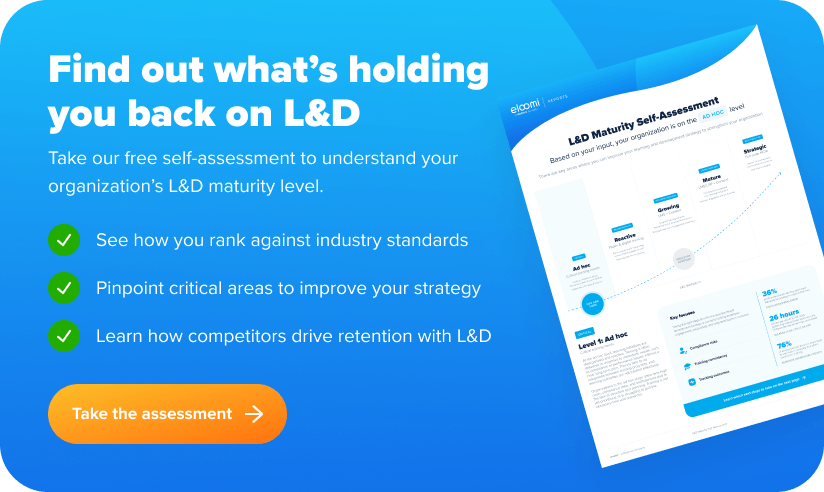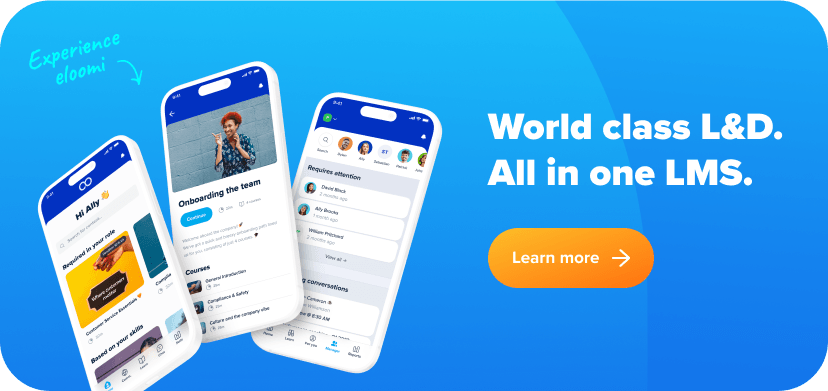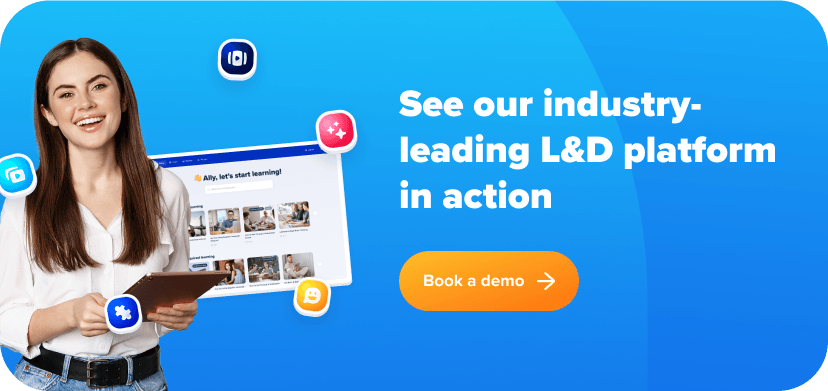This guide will help you recognize important LMS features for your checklist, suit your particular business needs, and make the right choice by comparing different vendors.
Why you need an LMS comparison checklist
The LMS market can quickly become overwhelming due to the sheer number of options available, making the selection process tricky. A detailed LMS comparison checklist helps streamline this process by:
- Providing a clear, side-by-side comparison of features across multiple platforms.
- Ensuring you don’t miss any key features that align with your learning objectives.
- Offering a structured way to gather feedback from stakeholders and decision-makers.
Without a checklist, the selection process can become disorganized, leading to decisions based on incomplete information or superficial assessments of the platforms. As well as this, a checklist forces you to think critically about what features are non-negotiable for your organization versus those that are “nice to have.”
A properly constructed LMS feature comparison will save you time and money by narrowing down your options and ensuring you’re only spending time evaluating platforms that truly meet your needs.

Key features to include in your LMS comparison checklist
Although every organization will prioritize different aspects of an LMS, there are universal features that any checklist should include. Whether you’re a small business or a large enterprise, these core features will ensure the system can meet your immediate and future needs.
User experience
A platform that’s easy to navigate for both learners and administrators reduces friction and maximizes engagement, so it’s important to look for a system with an intuitive interface, clear navigation, and features that enhance user satisfaction such as mobile compatibility and accessibility features.
For administrators, the UX should include simple tools for managing users, assigning courses, and tracking progress, due to the nature of these tasks being of high volume.
Course creation tools
Whether you’re developing custom content from scratch or using pre-built modules, the system should offer flexibility when it comes to course creation. Keep an eye out for:
- Drag-and-drop course builders for ease of use.
- Support for multimedia, quizzes, assessments, and interactive elements to keep learners engaged.
- Templates for rapid course development.
An LMS should allow you to tailor content to your organization’s unique training needs. For example, pre-built compliance courses can cover mandatory training, but it can’t show you where the fire escapes are in your building. Having an LMS with content authoring capabilities allows you to fill in that gap, making it simple to align learning materials with your company’s goals and culture and in turn improving both engagement and training effectiveness.

Tracking and reporting
Tracking progress is a must-have feature for any LMS, with complete reporting tools available that allow you to:
- Monitor learner engagement, course completion, and assessment scores.
- Generate custom reports based on KPIs such as training hours, completion rates, and learning outcomes.
- Automate recurring training as well as deadlines and reminders to ensure training completion
Tracking performance not only helps you measure the effectiveness of your learning programs and courses, but also provides you with the data needed to continuously improve them.
Integration capabilities
Most organizations already use various software tools to manage operations, from CRM systems to HRIS tools. Your LMS should therefore be able to integrate seamlessly with these existing systems to enable smoother data transfer, minimise manual entry, and reduce the risk of errors occurring. Common integrations include:
- HRIS integrations for tracking employee data and performance.
- Single Sign-On (SSO) for easy access across tools.
- Communication platforms like Microsoft Teams for in-course collaboration.
An LMS with robust API support is especially ideal if you anticipate the need for custom integrations.
Scalability
Scalability is a consideration that shouldn’t be overlooked; the capacity for an LMS to scale with an increasing number of users and larger volumes of content without sacrificing performance may outright determine whether or not it’s the right choice. Look for:
- The ability to add more users and features without overhauling the entire system.
- Access to training content for a range of skills, roles, and topics.
- Automation of HR workflows for processes like onboarding, performance management, or compliance training..
Ensuring that your LMS can scale will prevent future disruptions and help you avoid outgrowing the platform too quickly.
Support and training
Even the most user-friendly LMS will require support at some point so having reliable customer service and thorough training resources are essential. These can include:
- 24/7 support via phone, chat, or email.
- A comprehensive knowledge base with tutorials, videos, and documentation.
- Regular webinars and training sessions to help you get the most out of the platform.
Vendor support isn’t limited to troubleshooting, but also for making sure your team is in the best position to leverage all of the platform’s features effectively.
Development planning
What makes eloomi stand out is its ability to connect learning with performance management. While some LMS platforms focus solely on delivering training, eloomi integrates learning with individual development plans and performance tracking. This enables HR and L&D teams to build learning paths that tie into broader organizational objectives, such as leadership development or upskilling.
By combining learning and performance management, you ensure that training isn’t just a one-off event but part of an ongoing process to improve employee performance and foster growth.

How to customize your LMS checklist for your organization
A standard LMS comparison checklist is a great starting point, but you’ll need to tailor it to fit your unique organizational needs. Consider factors such as:
- Industry-specific requirements; for example healthcare organizations may prioritize compliance tracking, while retail companies may need tools for smooth seasonal onboarding.
- Larger companies may require advanced reporting and compliance features, while smaller companies might focus on ease of use and cost-effectiveness.
- Think about whether your immediate training needs focus on onboarding, skills development, compliance, or leadership training.
LMS comparison: evaluating vendors and platforms
Once you’ve created a checklist, the next step is evaluating vendors, where multiple platforms can be compared:
- Use your checklist to shortlist vendors by starting with a broad list, then narrowing it down to those that meet your top requirements.
- Demos and trials can be used to evaluate not just the features, but how the platform feels in real-world scenarios.
- While many platforms offer similar features, consider the vendor’s track record, customer reviews, and their vision for future updates.
eloomi positions itself as a full-solution platform, offering both an LMS and integrated performance management tools, making it a holistic solution for organizations focused on long-term employee development.
Steps for making an informed LMS decision
Once your options have been narrowed down, it’s time to make an informed decision that is well-rounded and covers all aspects:
- Collect feedback from key stakeholders by involving department heads, HR, IT, and end-users to gather insights from all levels of the organization.
- Have different teams use the platform during the trial period to assess functionality and user experience.
- Even though it’s sometimes tempting to go with the lowest-cost option, consider the platform’s long-term ROI, including improvements in training outcomes and employee satisfaction.
By following these steps, you’ll be better placed to make a well-informed decision that meets both your immediate and future needs.
Moving forward with the right LMS
An LMS comparison checklist is an invaluable tool for navigating the crowded LMS market. By focusing on key features, tailoring your checklist to your organization’s needs, and conducting thorough vendor evaluations, you can give yourself the best chance of selecting the right platform.
Choosing an LMS with the right balance of features, scalability, and support will position your organization for ongoing learning and development success. Find out more about eloomi and its key features or if you have any specific questions, get in touch with our friendly team.







